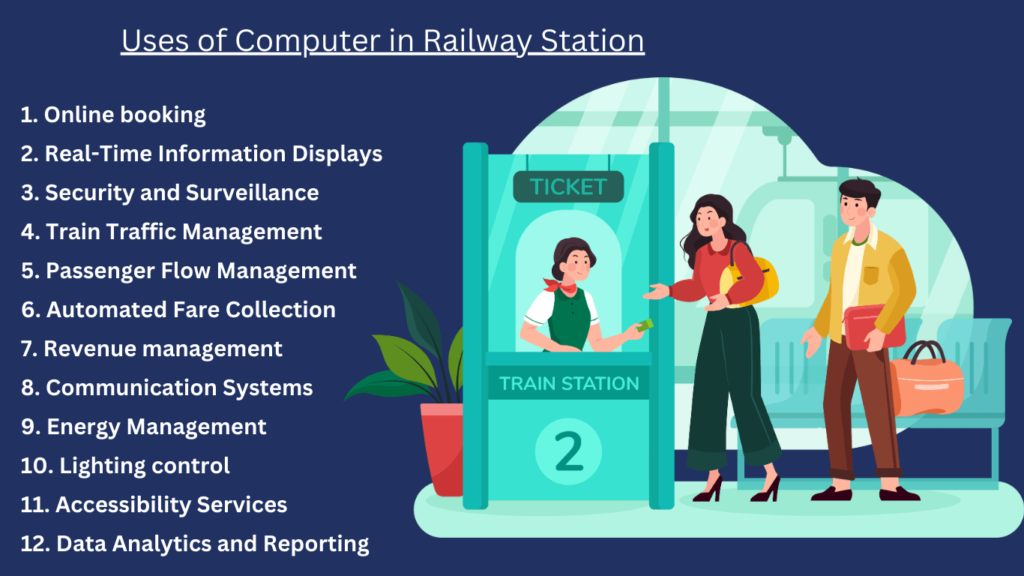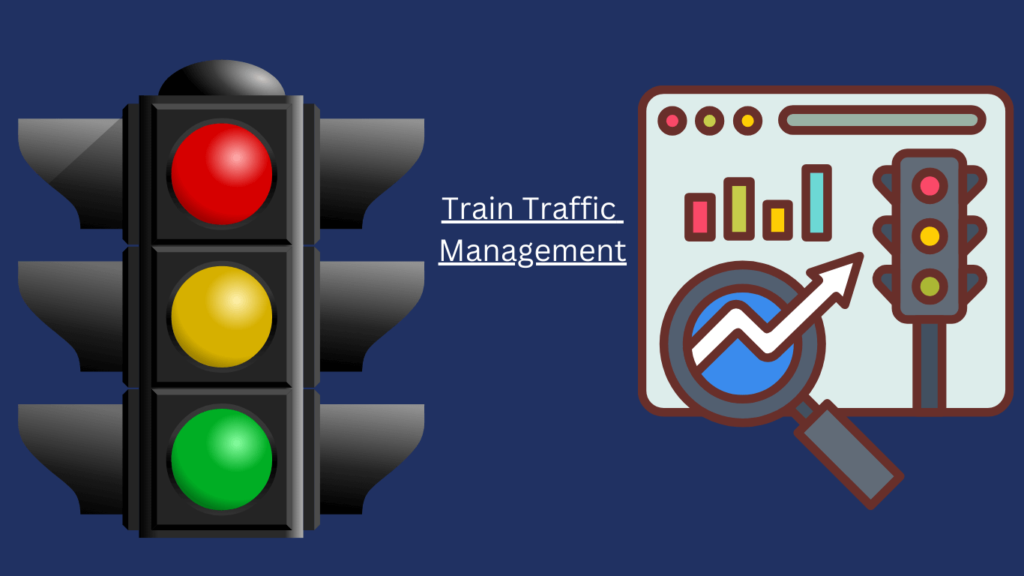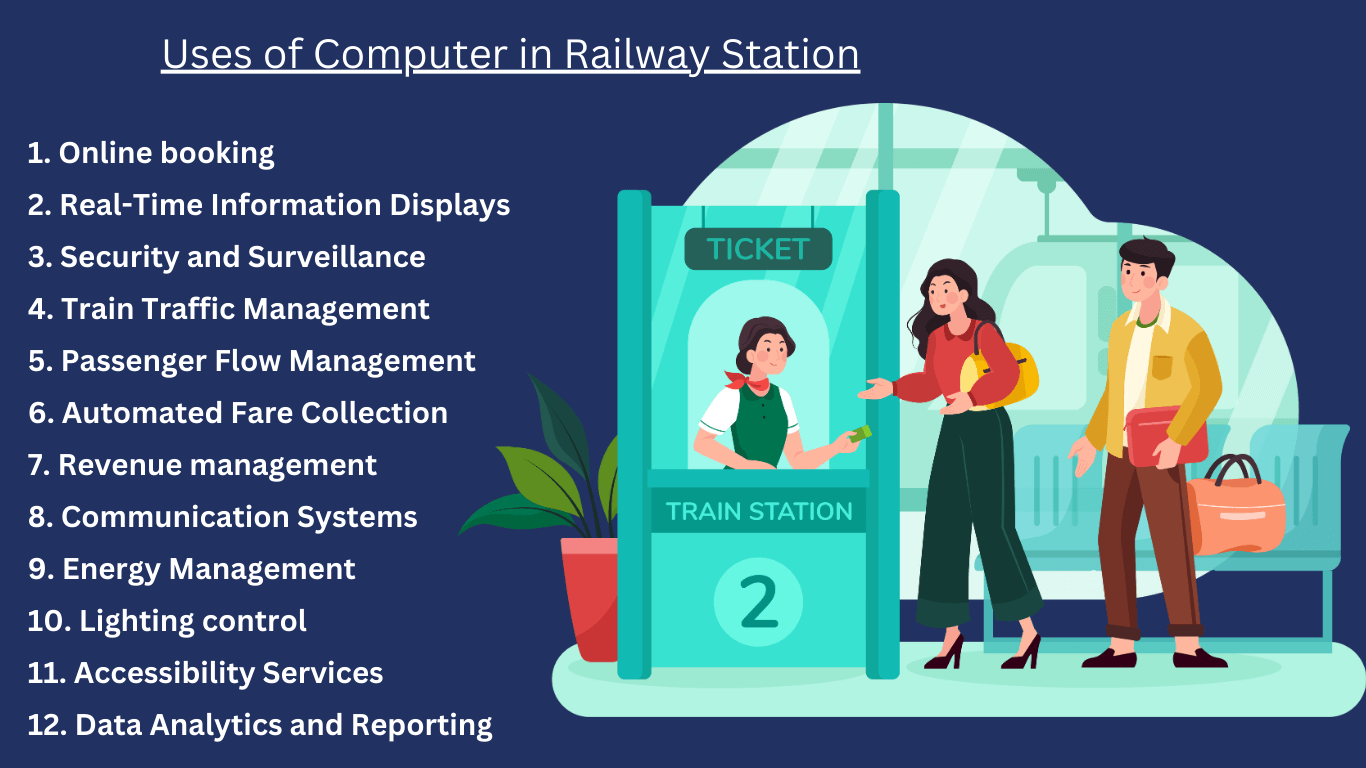If you want to know Uses of Computer in Railway Station then follow this article. In this article we will discuss about benefits for use computer in railways stations.

1. Online booking
Online platforms and mobile applications have made train ticket reservation more accessible. This system allows for more efficient management of available seats and helps optimize revenue.
Fare calculation has become more sophisticated with computerized systems. For instance, some systems charge a base fare for a certain number of stations, with additional charges for longer journeys. This flexibility allows for more dynamic pricing strategies and improved revenue management.
2. Real-Time Information Displays
Real-time information displays play a crucial role in enhancing the commuter experience at railway stations. These systems provide passengers with up-to-date information, helping them plan their journeys effectively. Inside metro stations, digital information boards processed by computers display essential details for travelers.
Train station displays show live and real-time train status, including arrival and departure times. This allows commuters to check schedules instantly, reducing uncertainty and minimizing the risk of missing trains. The integration of passenger information systems with displays enables automatic updates as schedules change.
Real-time systems provide accurate platform information, allowing passengers to position themselves correctly on the platform. This saves time and effort for travelers, streamlining their journey through the station. Clear station announcements complement visual displays, though it’s important to note that passengers with hearing difficulties or those wearing headphones may miss audio information.
3. Security and Surveillance
Railway stations employ advanced security and surveillance systems to ensure passenger safety and operational efficiency. These systems utilize cutting-edge technologies to monitor, detect, and respond to potential threats.
IP-based CCTV systems play a crucial role in modern train surveillance. These cameras provide mission-critical information, enhancing operational efficiency and passenger safety. They deliver high-quality imaging in various lighting conditions and extreme environments, ensuring continuous performance.
Advanced access control systems regulate entry to crucial areas like control rooms and maintenance facilities. Using technologies such as bio metrics and key cards, these systems enhance safety, prevent unauthorized access, and streamline operations .
4. Train Traffic Management
Modern railway systems rely heavily on computerized traffic management to ensure safety and efficiency. Advanced technologies have revolutionized train control, signaling, and collision avoidance.
Automated traffic management systems improve network operations by optimizing route selection and reducing delays. These systems use data from track side equipment and signaling centers to provide drivers with clear information in the train cab. This upgrade allows for more trains on the network and improved journey times .

Railway Collision Avoidance Systems (RCAS) use train-to-train communication to exchange vital information such as position, speed, and intended track . This data enables early warning systems for drivers and can even intervene in braking if necessary . Some systems employ machine vision and edge AI to detect obstacles and calculate collision probabilities in near-real-time .
5. Passenger Flow Management
Video analytics systems utilize existing CCTV networks to measure passenger density in real-time . Thales’ DIVA solution uses color codes to indicate crowd density, guiding passengers away from crowded areas via platform displays . Heat maps provide operators with an overview of passenger movements across the entire system .
Computer vision solutions enable automated and safe platform and train screen door systems . These systems help detect incidents like passenger slips and falls . By analyzing congestion points, station staff can make informed decisions to alleviate overcrowding .
6. Automated Fare Collection
Automated Fare Collection (AFC) systems have revolutionized public transit operations, offering friction less, end-to-end travel experiences for passengers . These systems utilize smart card technology and contactless payments to streamline ticketing processes and enhance revenue management.
Smart cards, embedded with microchips and antennas, have gained traction in public transit agencies . These cards offer increased convenience, security, and flexibility for riders while reducing cash handling and maintenance costs for operators . ITSO-compliant systems use secure application modules (ISAMs) to authenticate and validate electronic tickets, ensuring seamless travel across different modes of transport .
7. Revenue management
AFC systems enable centralized electronic ticket distribution, simplifying back-end billing and protecting revenue more securely. They provide near real-time data on customer behavior, allowing operators to gain insights into train usage and evaluate transit services . This data-driven approach helps optimize pricing strategies and maximize revenue growth in an increasingly competitive market .
8. Communication Systems
Public address (PA) systems play a crucial role in railway stations, providing passengers with essential information. These systems are designed to deliver clear announcements, with a minimum sound pressure level of 85 dB and at least 10 dB above ambient noise levels . Modern PA systems support remote announcements from central locations to remote stations, enhancing operational flexibility .
Emergency Notification Systems (ENS) at highway-rail grade crossings provide critical contact information for the public. These blue-and-white signs display the railroad’s emergency contact number and a unique identification number for the crossing . This allows for quick reporting of emergencies or safety concerns at specific locations.
9. Energy Management
Railway stations utilize advanced computer systems to optimize energy consumption. These systems manage power distribution, lighting control, and HVAC optimization, ensuring efficient operations and passenger comfort.
Stable and scalable hardware is crucial for 24/7 station management . Industrial-grade PCs and wayside controllers provide reliable platforms for critical information and emergency response solutions . These systems offer remote control access and rich I/O interfaces, meeting the requirements for integrated station control systems .
10. Lighting control
Building Automation Systems (BAS) control various station elements, including lighting . Industrial computers manage these systems based on pre-set data, allowing for automatic activation and maintenance . Remote control management software enables monitoring of current status, automatic alarms, and health checks, reducing system downtime .
11. Accessibility Services
Railway stations utilize advanced technology to enhance accessibility. Sensors installed on elevators and escalators collect real-time data, enabling quick detection of malfunctions . This system sends immediate email alerts, speeding up response times and revolutionizing maintenance practices .
12. Data Analytics and Reporting
Railway stations utilize advanced data analytics to gather crucial passenger information. Video analysis software can count and categorize passengers based on their behaviors and attributes, such as entry and exit patterns, accompanying children or animals, and handling bicycles . This data, when cross-referenced with ticket sales records, helps identify patterns in ticket usage and instances of fare evasion .
Real-time monitoring of railway systems has proven invaluable in improving overall performance . Data analysis enables better planning, informs decision-making, and reduces the risk of disruptive failures . Railroad Performance Metrics allow operators to monitor tracking performance data, anticipate transit time effects, and compare railroad velocities and delays .
Conclusion : Use of Computer in Railway Station
The integration of computer systems in railway stations has caused a revolution in the way these transportation hubs operate and serve passengers. From ticketing and security to traffic management and accessibility services, technology has a significant impact on every aspect of station operations.
Looking ahead, the continued evolution of computer technology in railway stations promises to bring even more innovations to improve passenger services and operational efficiency. As artificial intelligence and machine learning capabilities grow, we can expect to see more personalized travel experiences and smarter, more responsive station management systems.
Related Post
FAQs : Uses of Computer in Railway Station
Q1. How are computers utilized in railway stations?
Ans. Computers are integral to railway operations, primarily used for booking tickets and managing train schedules. Ticket agents utilize computers to check seat availability during reservations. Additionally, in underground rail systems, computers are crucial for controlling train movements.
Q2. What are ten common applications of computers in everyday life?
Ans. Computers are ubiquitous in daily activities, especially in office environments where they aid in creating documents, managing data, handling accounting, and facilitating communication. Furthermore, they are pivotal in supporting business functions such as online transactions and digital marketing.
Q3. In what ways have railroads implemented computer technology?
Ans. Railroads have adopted computer-aided dispatching (CAD) systems to enhance the safety and efficiency of train operations. These systems assist dispatchers by processing information that helps manage train movements effectively.
Q4. What type of computer system is employed by railways for customer interactions?
Ans. Mainframe computers are predominantly used by railways, especially in India, to handle various online customer interactions and functions.
